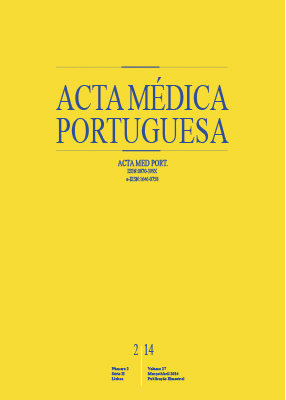Espondilodiscite Brucélica: Casuística dos Últimos 25 Anos
DOI:
https://doi.org/10.20344/amp.4117Resumo
Introdução: A brucelose é uma zoonose endémica em Portugal, sendo a espondilodiscite brucélica uma das manifestações focais
mais frequentes. Pode provocar sequelas graves, apesar da terapêutica dirigida.
Material e Métodos: Estudo retrospectivo dos processos dos doentes com espondilodiscite brucélica, internados no Serviço de Doenças Infecciosas do Centro Hospitalar e Universitário de Coimbra, num período de 25 anos (1988-2012).
Resultados: Foram identificados 54 doentes, 55,6% do sexo masculino, com idade média de 54,8 anos. Em 81,5% identificou-se contexto epidemiológico, maioritariamente contacto com gado ovino e caprino. A duração da sintomatologia prévia ao diagnóstico foi de 5,5 meses. Os sinais e sintomas mais frequentes foram: dor (98,1%), febre (46,3%) e défices neurológicos (25,9%). A ressonância magnética nuclear da coluna foi o exame imagiológico mais usado (77,8%) evidenciando abcessos em 29,6% dos doentes. A localização
lombar predominou (77,7%). O diagnóstico etiológico foi confirmado em 47 doentes (87,0%): microbiologicamente (3 doentes), serologicamente (32 doentes) ou por ambos (12 doentes). As associações de doxiciclina com rifampicina (64,8%), ou estreptomicina (24,1%) foram as mais utilizadas, com duração média de 4,4 meses de tratamento. Um doente teve indicação cirúrgica para drenar abcesso. A evolução foi maioritariamente favorável (92,6%), sem óbitos.
Discussão: A investigação de contexto epidemiológico revelou ser uma peça importante na suspeita do diagnóstico. O tratamento da brucelose osteoarticular ainda é controverso.
Conclusões: A espondilodiscite brucélica deve ser considerada no diagnóstico diferencial dos doentes com lombalgia, mesmo na
ausência de febre, particularmente em regiões onde a doença é endémica. O esquema antibiótico, sua duração e a necessidade de cirurgia deverão ser individualizados, com vista a um melhor prognóstico. O número de casos tem diminuído ao longo dos anos, facto relacionado com melhor controlo da endemia animal.
Downloads
Downloads
Publicado
Como Citar
Edição
Secção
Licença
Todos os artigos publicados na AMP são de acesso aberto e cumprem os requisitos das agências de financiamento ou instituições académicas. Relativamente à utilização por terceiros a AMP rege-se pelos termos da licença Creative Commons ‘Atribuição – Uso Não-Comercial – (CC-BY-NC)’.
É da responsabilidade do autor obter permissão para reproduzir figuras, tabelas, etc., de outras publicações. Após a aceitação de um artigo, os autores serão convidados a preencher uma “Declaração de Responsabilidade Autoral e Partilha de Direitos de Autor “(http://www.actamedicaportuguesa.com/info/AMP-NormasPublicacao.pdf) e a “Declaração de Potenciais Conflitos de Interesse” (http://www.icmje.org/conflicts-of-interest) do ICMJE. Será enviado um e-mail ao autor correspondente, confirmando a receção do manuscrito.
Após a publicação, os autores ficam autorizados a disponibilizar os seus artigos em repositórios das suas instituições de origem, desde que mencionem sempre onde foram publicados e de acordo com a licença Creative Commons









